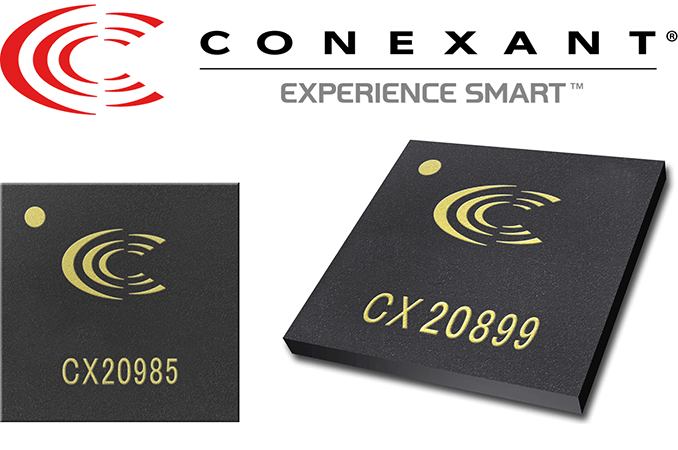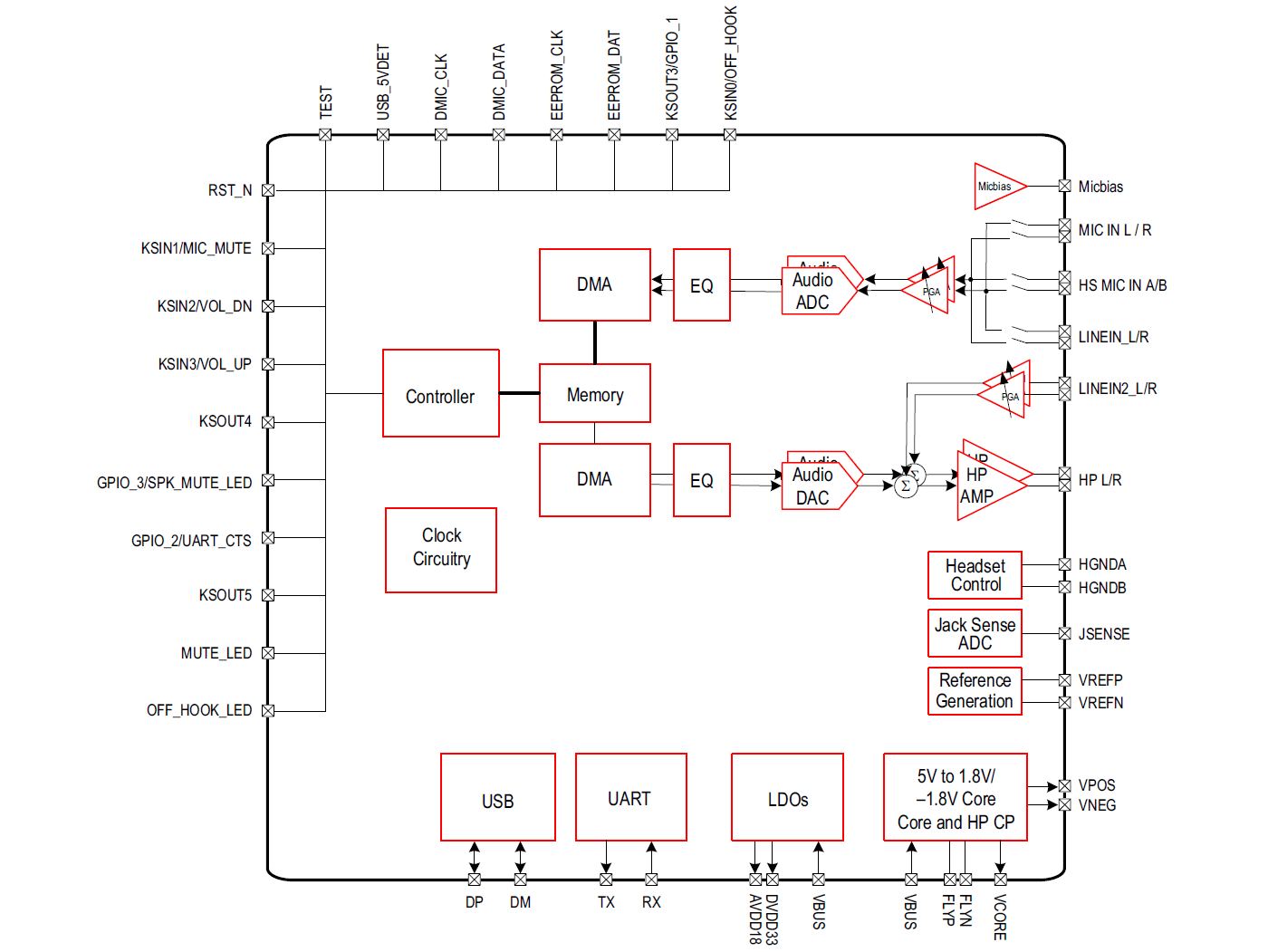Conexant Introduces USB-C Digital Audio Compliant Chips
by Anton Shilov on May 11, 2016 8:30 AM EST- Posted in
- Mobile
- Intel
- Conexant
- USB-C
- USB-C Digital Audio

Just recently, Intel announced a proposal for its part in the USB-C Digital Audio specification, which is expected to be finalized in the coming weeks. Judging by our email, the first chips compliant with the new spec were announced on Tuesday by Conexant, and we asked for more information. These chips are about to hit mass production in mid Q2, therefore the first devices with USB-C Digital Audio might be expected to hit the market later this year.
Conexant introduced two new AudioSmart CODECs which are designed specifically for smartphone headsets and docking stations that use USB Type-C connection. We are told that the CX20985 and the CX20899 are to be compliant with the yet-to-be-released USB-C Digital Audio specification, and they support enterprise requirements for Skype for Business as well as meet the Android Wired Audio Headset specification. Both chips support USB 2.0 bandwidth of up to 480 Mbps, which should be enough for audio as well as additional functionality. Finally, the parts support four-conductor CTIA and OMTP headsets with up to eight buttons and can auto-detect and auto-switch between them. Since these are two very different chips with dissimilar capabilities, let’s talk about them separately.
The Conexant CX20985 is specifically designed for headsets, but it could be used for other audio applications too. The chip integrates a stereo 24-bit DAC and stereo ADC for music and voice communication applications and supports sampling rates of up to 48 kHz. Besides this, the CX20985 has a built-in capless headphone driver that eliminates the cost and space of AC coupling capacitors. In addition, the chip sports a five-band parametric equalizer for playback, a two-band equalizer for recording, and adjustable microphone boost circuitry. The CX20985 is promoted with minimal power consumption: the specification sheets list the nominal idle current as 22.6 mA with a voltage between 4.35 and 5.25 V. The CX20985 is set to hit mass production in July and is projected to be available in 6×6 mm 50-pin QFN package.
While the CX20985 should be fine for mainstream headsets, Conexant does not expect it to be used for higher-end digital headsets. The chip does not support sampling rates higher than 48 kHz, something that their Hi-Fi audio partners and customers expect. By comparison, the CX20899 has improved DAC and power supply circuitries, which will effect the quality of analog audio.
The Conexant CX20899 is optimized for larger devices, such as docking stations, yet it could be used to build higher-end headsets as well. This chip is considerably more advanced than the CX20985: it features a fully-fledged digital signal processor (DSP), supports sampling rates up to 96 kHz (both on DAC and ADC) as well as stereo playback path with differential line-out or capless headphone driver. The DSP fully supports functions as acoustic echo canceling, noise reduction, a programmable equalizer, digital room correction, microphone AGC (automatic gain control), volume control, and a microphone boost. The CX20899 also supports PCM/I2S and S/PDIF digital audio interfaces which should help to build docking stations for mobile devices and subsequently connections to Hi-Fi audio equipment via USB-C. The power consumption of the CP20899 is listed as a nominal idle current is 1.8 mA with a voltage is between 4.35 and 5.25 V. The chip uses a 76-pin QFN package and is currently in mass production.
Conexant was one of the early adopters of the USB Audio technologies many years ago and it is not surprising that it is also among the first to support the USB-C Digital Audio technology. Going forward, Conexant intends to introduce more sophisticated USB-C Digital Audio-compliant chips, which will enable health-monitoring headsets as well, following the wearable/health trend in the market.
Conexant does not reveal pricing of its chips for digital headsets, but typically such chips are not very expensive. For example, Conexant’s previous-generation USB Audio-compliant semiconductors for headsets cost around $1 per unit.
Source: Conexant












31 Comments
View All Comments
damianrobertjones - Wednesday, May 11, 2016 - link
Gosh! I'm glad that they made that fast enough... anyone would think that these oems have known about it for a looooonnnggg time /sdamianrobertjones - Wednesday, May 11, 2016 - link
"Going forward, Conexant intends to introduce more sophisticated USB-C Digital Audio-compliant chips"They could do this NOW but that wouldn't MILK customers from their $$$$
willis936 - Wednesday, May 11, 2016 - link
"What should we do now that transistors are so cheap?""Let's replace existing solutions with less convenient ones."
Murloc - Wednesday, May 11, 2016 - link
having literally everything on USB-C is arguably convenient.sadsteve - Wednesday, May 11, 2016 - link
I don't particularly like this idea. Here are some the problems I see:1) Your adding a lot of complexity, hardware and software wise (points of failure), to a rather simple device that works well.
2) Your headphones/earbuds are now going to be a fair amount more expensive.
3) Your new headphones are incompatible with your existing stereo/tv/computer equipment so you'll still have to keep the old set around.
4) Every pair of USB headphones I've purchased have only lasted a few years, yet the old school AKG K240's headphones I bought in the 80's are still working great.
5) Do you really think the cell phone manufacturers are going to put 2 USB-C connectors on you new cell phone? If not, you'll not be listening to music from you phone while it's recharging on your desk.
debdrup - Wednesday, May 11, 2016 - link
I agree that there are problems, and USB-C headphones/earbuds (though the latter has no interest for me) is not something I want - but these chips include a DAC so it's not likely that the price of the headphones will be higher, at least from a manufacturing standpoint. Who knows what they'll actually sell for, though.Murloc - Wednesday, May 11, 2016 - link
1) an IC usually works or it doesn't, I don't think it's something that will kill headphones faster than the usual problems (connectors not holding up the test of time) that kill earbuds after a few years.2) that's to be seen, but how many popular brands of headphones are really sold at cutthroat margins? People are even paying for the brand only (e.g. beats and apple). And many people use the earbuds that came with their phone. I think the price difference will be negligibly small in the long term.
3) I'm sure analog headphones will keep getting sold, especially in the enthusiast and professional range of products, and in the ultra low end too at least for several years, assuming the manufacturers all adopt this and start dropping the jack port on smartphones of course. If the jack doesn't get dropped because it's not worth it, nothing happens.
4) The mobile mass market of cheapish headphones is the important objective.
Audiophile market is another story and I'm sure everything analog will stay available, especally since including analog ports on desktop towers, AVRs, stereo sets, etc. is absolutely not a problem.
The whole point of headphone DACs is having a decent DAC instead of your computer's. That's not going away because of cheap DACs put inside mass market headphones.
5) A pretty rare use case I think, and a company like Apple could put another USB-C port on the charger to satisfy this use case, their accessories are already outrageously expensive anyway.
Basically I see no reason to panic.
The usefulness of this thing is debatable but I have no idea how much of a limitation having to include a jack port is for portable devices, if it's significant this thing will probably take off.
sadsteve - Wednesday, May 11, 2016 - link
Eh, I'm not panicking. I don't listen to music on my cell phone anyway.It really just appears to be a way to add complexity and cost to a device that's been work perfectly fine for decades. I only see benefit here for the manufactures and not for the consumer.
zodiacfml - Friday, May 13, 2016 - link
They are pushing this because there's plenty of capability/feature that can be had with USB type interface for a headphone/headset. The one I liked is an earphone that also functions as a microphone through the ear so phone calls are dead quiet without noise cancellation.Yet for audio applications, this is nothing but probably a bit of inconvenience.
SunnyNW - Wednesday, May 11, 2016 - link
One thing I would worry about is them replacing a decades old audio jack with USB type-C thats going to be around for how long? The USB connectors have been iterated upon rather quickly inthe grand scheme of things. It seems the only answers I'm seeing to many questions are adapters... How many people want to have to carry around an adapter? Of course this is perfect for the headphone companies, especially ones like Beats, they can sell you a new pair when USB type-D comes around because people like convenience, not having to carry around adapters...